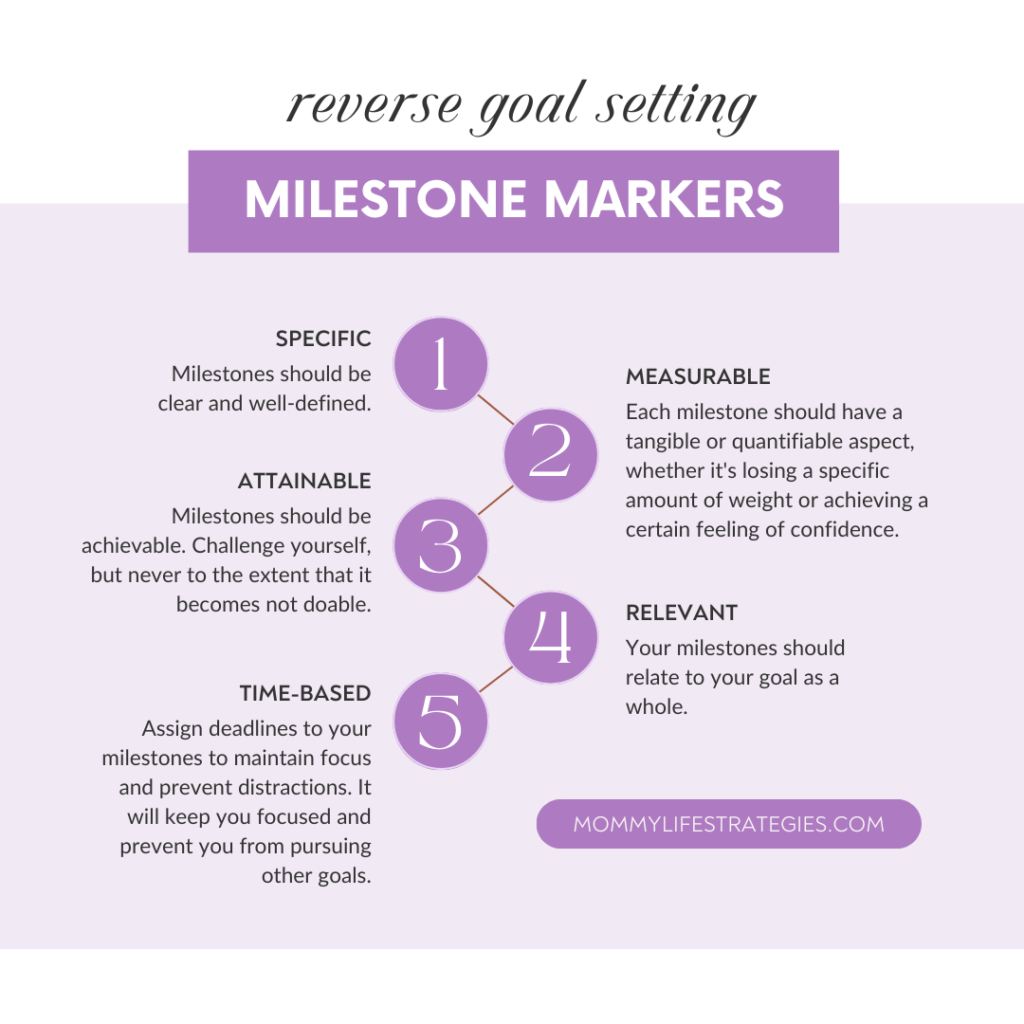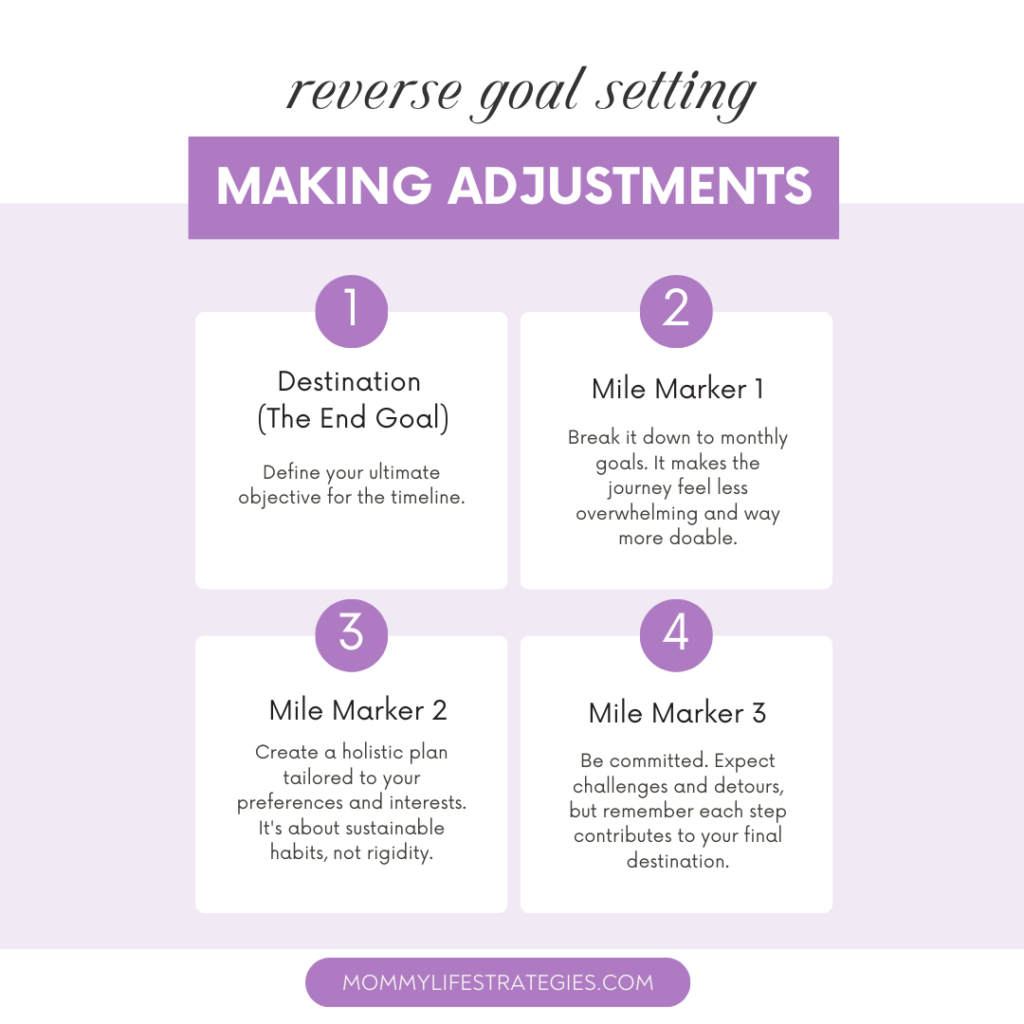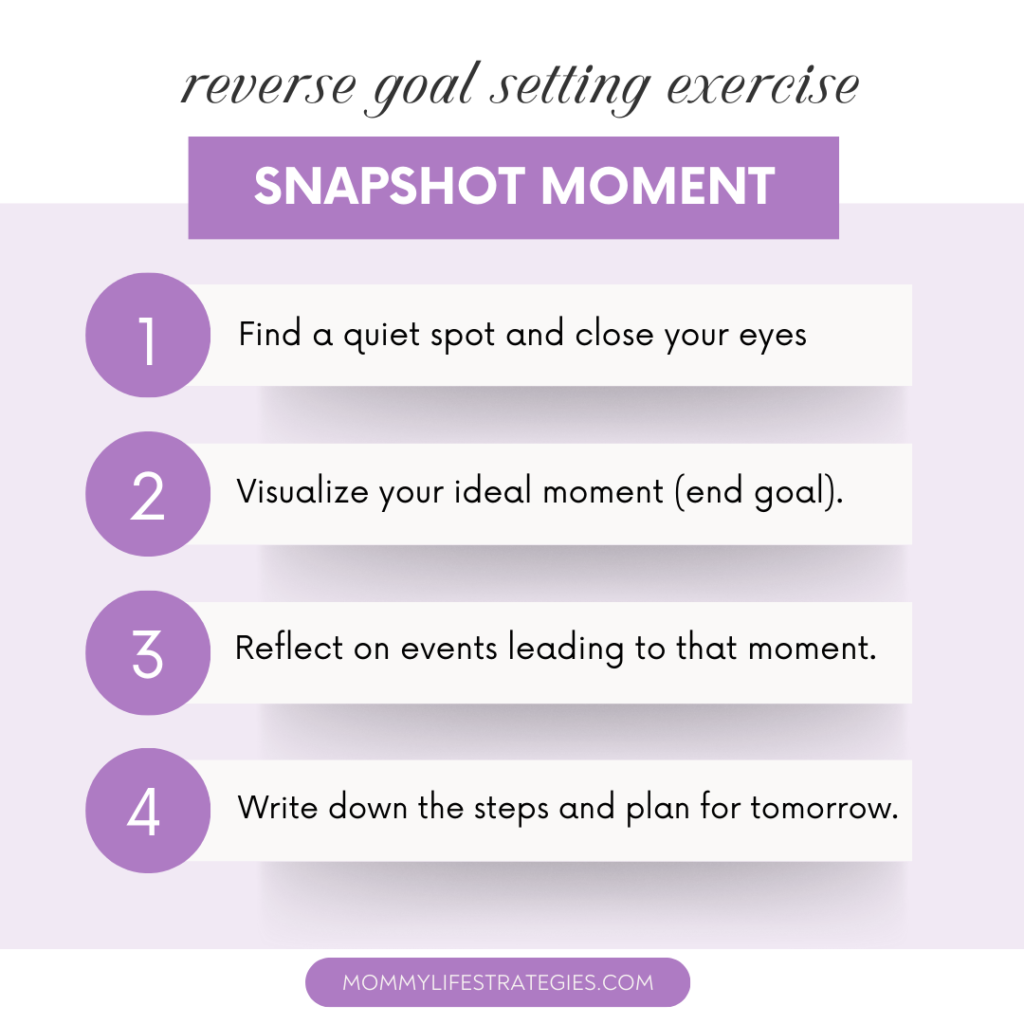
Have you ever felt that your usual way of setting goals just isn’t cutting it, especially with your busy mom schedule?
Here’s a fresh alternative: “Reverse Goal Setting”.
While it might seem a bit unconventional at first, it’s genuinely effective. Rather than mapping a vague path forward, this method prompts you to first envision your goal and then carefully trace your steps backward to where you are now. It’s somewhat like planning the conclusion of a book and then filling in the preceding chapters.
What makes this approach stand out is its emphasis on appreciating each step. It’s like plotting out a journey where every milestone matters, not just the final destination. With this ‘reverse perspective’, you gain clarity on your route, ensuring you remain on track and sidestep any unnecessary detours.
Sounds interesting? Keep reading to discover more about this backward planning method and how you can get a step-by-step guide to setting goals using this reverse method.
Want to try a new angle on achieving your goals? Dive into backward planning with my Reverse Goal Setting and Planning Worksheet for Busy Moms– an empowering method to visualize your goal and work your way back to success.

Setting goals can be overwhelming
Use a method that makes it easier to break down your goals into manageable steps.
With these reverse goal-setting worksheets, you can do just that more quickly and easily.
Try the reverse (aka backward design) goal setting method using my simplified step-by-step worksheets.
Don't wait till the new year, get a head start today. Grab the worksheets!
Thank you!
You have successfully joined our subscriber list.
**Please check your Spam folder and whitelist mommlifestrategies if you want to receive emails from me**
What is Reverse Goal Setting?
Think of reverse goal setting like cooking by looking at the final dish and then figuring out the ingredients. Instead of just dreaming about the finish line, you start there and trace your steps back to the starting block.
The basic premise is simple: Start at the destination to identify those things you have to complete to arrive here.
Imagine you’ve got this end picture in your head. Now, instead of just hoping to get there, you break it down, step by step. Kind of like retracing your steps when you’ve misplaced your keys. By laying it out this way, it becomes so much clearer what needs to be done at every twist and turn.
What’s neat about this is you focus more on the journey than just the destination.
It’s like plotting a road trip by all the cool stops you’ll make, rather than just the final city. So, if you’re chasing after something – big or small – why not give this ‘reverse thinking’ a whirl?
It might just make the path a whole lot clearer and keep you from distractions along the way.
How is Reverse Goal Setting Different from Other Methods?
You know how, when baking, you sometimes picture that perfect, gooey chocolate chip cookie first, and then pull out the ingredients? That’s a bit like reverse goal setting.
Instead of starting with the small steps, you kick off with your ultimate goal in mind and then backtrack to map out how to get there.
Other methods start at the beginning and hope you land where you want.
But with reverse goal setting, by visualizing the end first, like that cookie, you can whip up a clearer, more focused recipe for success.
Benefits of Working Backwards When Setting Goals
Taking a step back, you know, sometimes it’s helpful to start at the finish line and work our way back when setting goals.
It’s like looking at a picture of the finished puzzle and then figuring out how to put the pieces together. Often, when we just dive into tasks, we’re so caught up in the ‘doing’ that we might lose sight of why we started in the first place.
If we’re only looking at the immediate steps, it’s like hiking with our eyes glued to our shoes—we might miss a turn or two and end up lost.
But, by focusing on the end game, it’s like having a map. We can plot out what to do each day or week, making the journey a bit less daunting. Instead of this giant mountain of a task, we can see it as a series of small hills.
So, if you ever find yourself spinning your wheels trying to achieve something, maybe give this reverse approach a shot.
Putting Reverse Goal Setting Into Action
Even if you’re a busy mom, reverse goals can be transformational. By starting with the end in mind, you get a clear vision of your desired outcome, making each step towards it more purposeful.
This approach not only boosts your motivation, as you can vividly see what you’re striving for, but it also maintains your focus.
Every action you take is directly tied to that final goal, ensuring that you stay committed and on track, even amidst the daily chaos
Here are four steps to setting up your reverse goals:
Four Steps to Reverse Goal Setting
- Define your goal
The first step is to clearly define your goal. What do you want to achieve? What are your desired outcomes? Be as specific as possible.
- Create a timeline
Once you have defined your goal, it’s time to create a timeline. Give yourself a deadline to achieve your goal. This will help you stay on track and motivated.
- Identify the steps needed to reach your goal
Now it’s time to identify the steps needed to reach your goal. What do you need to do to achieve your desired outcome? Create a step-by-step plan.
- Take action
The final step is to take action and start working towards your goal. Follow your plan and stay focused on your goal. You can achieve anything you set your mind to!
An example of reverse goals
Let’s say that your goal is to have one hour of uninterrupted “me-time” every day. You can reverse this goal by thinking about what you want the result to be.
In this case, you would want to have 7 hours of personal time in a week. Once you have the result in mind, you would then work backward to the present day. You would create steps that would help you to achieve your goal.
Here’s what it would look like:
- You want 1 hour of “me-time” every day.
- You determine which activities can be delegated or scheduled at different times to free up that hour.
- You create a plan that might include setting up a daily routine, assigning chores to kids, or planning ahead.
- You create a timeline for when you will start implementing these changes.
Reverse goals help you to better visualize the steps needed to achieve your goal. This technique can also help to keep you motivated and focused on your goal.

Setting Milestones to Measure Your Progress
Laying Down Milestone Markers
Measurement is necessary when you want to work towards an achievement. This is where the milestone comes into play.
Milestones are the events or accomplishments you do on the way to your goal. They are there to keep your progress in check so that you continue moving forward.
When setting milestones, it’s important to keep the following in mind:
- Specific: Milestones should be clear and well-defined.
- Measurable: Each milestone should have a tangible or quantifiable aspect, whether it’s losing a specific amount of weight or achieving a certain feeling of confidence.
- Attainable: Milestones should be achievable. Challenge yourself, but never to the extent that it becomes not doable.
- Relevant: Your milestones should relate to your goal as a whole.
- Time-based: Assign deadlines to your milestones to maintain focus and prevent distractions. It will keep you focused and prevent you from pursuing other goals.
Some examples of milestones you might set for yourself include:
If your goal is to have an hour of uninterrupted “me-time” every day:
- Schedule and stick to a 20-minute personal relaxation session three times a week for 8 weeks.
- Delegate or outsource one household task every week for 8 weeks.
- Set up a daily routine and adhere to it for 8 consecutive weeks.
If your goal is to start your own business:
- Research business ideas for 2 weeks.
- Choose a business model and start developing a business plan.
- Find a co-founder or partner.
- Launch a website or online store.
No matter what your goal is, setting milestones is a great way to measure your progress and keep yourself on track.

Making Adjustments to Your Reverse Goal Plan
When it comes to setting goals, it’s important to remember that the process is never really “done.”
Setting goals is a lot like growing up; it’s an ever-evolving journey. Just like how our favorite tunes or food cravings change over time, our goals do too. That’s perfectly okay and a sign you’re growing!
If you’re looking for a solid way to navigate this journey, let’s talk about the ‘backward goal setting’ approach.
How to adjust your goals (example):
Destination (The End Goal): Rocking the scales 50 pounds lighter in a year.
Mile Marker 1: Break it down to monthly goals. It makes the journey feel less overwhelming and way more doable.
Mile Marker 2: Craft a lifestyle plan—food, workouts, everything—that you genuinely enjoy. It’s less about a rigid routine and more about what makes you feel good and stick with it.
Mile Marker 3: Stay the course. Sure, there might be some bumps and reroutes, but remember, every day counts towards your destination.
What’s great about this approach? If life throws a curveball (hello, mom life), you can rejig your plan without losing sight of where you want to end up. So, whenever you’re charting your next goal, try this roadmap method. Starting with the end might just be the fresh start you need!
Staying Motivated with Reverse Goal Setting
Keeping Your Enthusiasm Fueled with Reverse Goal Setting.
As a busy mom, you’re spinning many plates at once: coordinating playdates, mastering the art of quick dinners, and handling those surprise school projects.
It’s no wonder personal goals sometimes slip through the cracks. This is where reverse goal setting can be your secret weapon.
Picture your ideal calm evening – perhaps sipping tea and diving into a novel? Begin with that perfect moment in mind, then backtrack to carve out steps to get there.
Suppose you’re dreaming of a peaceful hour each evening. Consider prepping tomorrow’s lunch the night before or setting a consistent bedtime routine for the little ones.
The key is to mold these goals around your life, not against it. By focusing on small, daily victories, you pave the way for larger, lasting success.

Snapshot Moment: Reverse Goal-Setting Exercise
Visualization can be an effective motivator as well as taking action. Try the ‘Snapshot Moment‘ goal-setting exercise.
As a mom who is always seeking simpler and easier ways to accomplish a task, this exercise will help you set a goal with actionable steps in as little as 5 minutes.
Here’s how you do it.
Preparation:
- Find a quiet spot.
- Have a writing tool and paper or phone ready.
Visualization:
- Close your eyes.
- Imagine your ideal day.
- Identify a moment that brings you joy.
Documentation:
- Write down that ‘ideal moment’. This is your end goal.
- Reflect on the events leading up to that moment.
- Jot down 2-3 key steps or events.
Action:
- Plan one practical step for tomorrow related to your goal.
- Regularly visualize and adapt your steps.
Example: – Snapshot Moment: Enjoying a home-cooked dinner with family. – Steps Leading Up: Cooking together, delegating tasks, choosing a recipe.
Overcoming Challenges When Reverse Goal Setting
We all know setting goals is like having a roadmap for our dreams, right? But sometimes mom life tosses in a few detours and speed bumps, making it tricky to stay the course.
When you’re feeling stuck or like you’re climbing uphill, breaking that big dream down into bite-sized pieces can be a game changer.
Instead of staring at a mountain, you’re hopping over little molehills.
Like any goal, breaking it down into small bites can make it manageable and still feel doable in the face of challenges.
Real-Life Examples of Reverse Goal Setting for Moms
Need some ideas? Here are some real-life examples of reverse goal setting.
Dreaming of a Mom-cation: Think about those moments when all you need is a break (all moms have been there). Let’s say you’re daydreaming of a serene beach, like Hawaii. Start with that picture of you, cocktail in hand, watching the sunset.
Now, let’s work backward: When’s the best time to go? How will you travel? Where will you rest your head? By focusing on that Hawaiian paradise first, you sort out the nitty-gritty, ensuring you’ll be sipping that cocktail before you know it.
Smart Mom-Budgeting: Ever faced the challenge of wanting to save up for something special? Maybe it’s that family summer camp. Say you want a $1,000 budget.
Begin with the thought of your kids’ happy faces at camp, then reverse engineer: How much should you set aside monthly? What can you cut back on? By envisioning that goal ($1,000 in the bank), you can whip up a budget plan that fits.
Mompreneur Ventures: Launching a business (especially with little ones) is no small feat. Let’s say you’re dreaming of starting an online store for handmade baby clothes.
Picture the launch, with your designs being loved globally. Now, roll back: Which designs to start with? What’s your marketing strategy? How will the website look? Beginning with your successful launch, you can lay out the journey leading to it.
Healthy Family Dinners: Envision your family around the dinner table, savoring a wholesome meal, sharing their day, and leaving with happy tummies. Want this to be a regular scene? Start there.
Then rewind: What are some healthy recipes everyone would love? How can you prep in advance? Do you need to do a weekly grocery run or a monthly bulk purchase? With that end picture of a nourishing meal and happy faces, you can strategize meal plans that keep everyone eager for dinner time.
Self-Care Sundays: Imagine a calm Sunday where you have a pocket of time carved out entirely for yourself. Whether it’s indulging in a skincare routine, meditating, or diving into a hobby, it’s rejuvenating. If you’re aiming for consistent self-care Sundays, start with that vision of relaxation.
Roll it back: What activities would make you feel most refreshed? How can you delegate chores or arrange playdates for the kids during that time? Maybe even get a partner or another family member on board to help? Starting with that mental image of a relaxed, rejuvenated you can pave the way to make it a weekly ritual.
By imagining the end first, the journey can often become clearer and more doable. Whether it’s shared moments, nourishing meals, or some much-deserved ‘me-time’, visualizing the outcome can be your guide to success.
Will Reverse Goal Setting be a game changer for you?
Think of setting goals as building with bricks. It might be easier to picture the finished castle and then figure out how to stack those bricks. This is the concept of “reverse goal setting” also called “backward design.”
Why not give it a try? Here’s what you can expect with this goal setting method.
- Crystal Clear Vision: By starting at the finish line, your goals aren’t just daydreams. They become sharp, achievable blueprints.
- Stay on Point: Knowing your end game helps you laser-focus on what truly matters, ensuring no more drifting into random tasks.
- Your Success Map: Beginning with the end crafts a step-by-step guide, like breadcrumbs leading you to your goal without the usual distractions.
Will reverse goal setting be your secret sauce to achieving success? You won’t know until you try it.
It’s structured, yet flexible; simple, yet profound. Ready to give it a spin? With this approach in your toolkit, you’re set to embark on a goal-setting journey with gusto and clarity.
Start building those dreams, one reversed step at a time!

Setting goals can be overwhelming
Use a method that makes it easier to break down your goals into manageable steps.
With these reverse goal-setting worksheets, you can do just that more quickly and easily.
Try the reverse (aka backward design) goal setting method using my simplified step-by-step worksheets.
Don't wait till the new year, get a head start today. Grab the worksheets!
Thank you!
You have successfully joined our subscriber list.
**Please check your Spam folder and whitelist mommlifestrategies if you want to receive emails from me**
